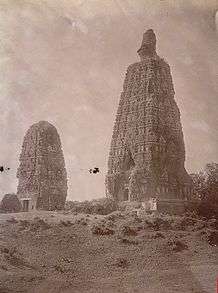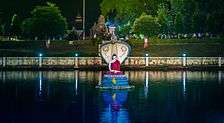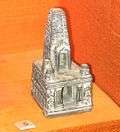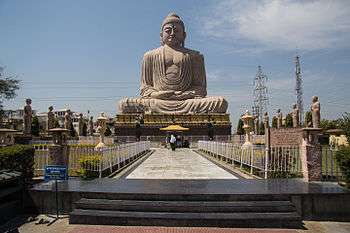Bodh Gaya
| Bodh Gaya Bōdh Gayā ji | |
|---|---|
|
Great Buddha Statue | |
 | |
| Coordinates: 24°41′42″N 84°59′29″E / 24.695102°N 84.991275°ECoordinates: 24°41′42″N 84°59′29″E / 24.695102°N 84.991275°E | |
| Country |
|
| State | Bihar |
| District | Gaya |
| Area(2015) [A 1] | |
| • City | 20.2 km2 (7.8 sq mi) |
| • Regional planning | 83.78 km2 (32.35 sq mi) |
| Population (2015) | |
| • Total | 45,349 |
| Languages | |
| • Spoken | Magadhi, Hindi |
| Time zone | IST (UTC+5:30) |
| PIN | 824231 |
| Vehicle registration | BR-02 |
| |
Bodh Gaya is a religious site and place of pilgrimage associated with the Mahabodhi Temple Complex in Gaya district in the Indian state of Bihar. It is famous as it is the place where Gautama Buddha is said to have obtained Enlightenment (pali: bodhi) under what became known as the Bodhi Tree.[2]
For Buddhists, Bodh Gaya is the most important of the main four pilgrimage sites related to the life of Gautama Buddha, the other three being Kushinagar, Lumbini, and Sarnath. In 2002, Mahabodhi Temple, located in Bodh Gaya, became a UNESCO World Heritage Site.[3]
History
| Pilgrimage to |
| Buddha's Holy Sites |
|---|
 |
| The Four Main Sites |
| Four Additional Sites |
| Other Sites |
| Later Sites |
Bodh Gaya is the most holy place for the followers of the Buddhist faith all over the world. Situated by the bank of river Neranjana the place was then known as Uruwela. King Ashoka was the first to build a temple here.[4]
Traditionally, Buddha was born in 563 BC in what is now Nepal [5][6] on the following auspicious Baisakhi purnima. As Siddhartha, he renounced his family at the age of 29 in 534 BC [7][8] and travelled and meditated in search of truth. After practicing self-mortification for six years at Urubela (Buddhagaya) in Gaya, he gave up that practice because it did not give him Vimukthi. Then he discovered Noble Eight-fold path without help from anyone and practiced it, then he attained Buddhatva or enlightenment. Enlightenment is a state of being completely free from lust (raga), hatred (dosa) and delusion (moha). By gaining enlightenment, you enter Nibbana, in which the final stage is Parinibbana.
At this place, the Buddha was abandoned by the five men who had been his companions of earlier austerities. All they saw was an ordinary man; they mocked his well-nourished appearance. "Here comes the mendicant Gautama," they said, "who has turned away from asceticism. He is certainly not worth our respect." When they reminded him of his former vows, the Buddha replied, "Austerities only confuse the mind. In the exhaustion and mental stupor to which they lead, one can no longer understand the ordinary things of life, still less the truth that lies beyond the senses. I have given up extremes of either luxury or asceticism. I have discovered the Middle Way". This is the path which is neither easy (a rich prince) nor hard (living in austere conditions practicing self-denial). Hearing this, the five ascetics became the Buddha's first disciples in Deer Park, Sarnath, 13 km n.e. of Benares.
The disciples of Gautama Siddhartha began to visit the place during the full moon in the month of Vaisakh (April–May), as per the Hindu calendar. Over time, the place became known as Bodh Gaya, the day of enlightenment as Buddha Purnima, and the tree as the Bodhi Tree.
The history of Bodh Gaya is documented by many inscriptions and pilgrimage accounts. Foremost among these are the accounts of the Chinese pilgrims Faxian in the 5th century and Xuanzang in the 7th century. The area was at the heart of a Buddhist civilization for centuries, until it was conquered by Turkic armies in the 13th century. The place-name, Bodh Gaya, did not come into use until the 18th century CE. Historically, it was known as Uruvela, Sambodhi, Vajrasana or Mahabodhi.[9] The main monastery of Bodh Gaya used to be called the Bodhimanda-vihāra (Pali). Now it is called the Mahabodhi Temple.
Five bombs were detonated in Mahabodhi temple premises on 7 July 2013. 4 bombs were also detonated in town while three were defused.
Mahabodhi Temple

The complex, located about 110 kilometres from Patna, at 24°41′43″N 84°59′38″E / 24.69528°N 84.99389°E,[10] contains the Mahabodhi Temple with the diamond throne (called the Vajrasana) and the holy Bodhi tree. This tree was originally a sapling of the Sri Maha Bodhi tree in Sri Lanka, itself grown from a sapling of the original Bodhi tree.
It is believed that about 280 years after the Enlightenment of the Buddha, Emperor Ashoka visited Bodh Gaya. He is considered to be the founder of the original Mahabodhi temple. It consisted of an elongated spire crowned by a miniature stupa and a chhatravali on a platform. A double flight of steps led up to the platform and the upper sanctum. The mouldings on the spire contained Buddha images in niches. Some historians believe that the temple was constructed or renovated in the 1st century during the Kushan period. With the decline of Buddhism in India, the temple was abandoned and forgotten, buried under layers of soil and sand.
The temple was later restored by Sir Alexander Cunningham in the late 19th century. In 1883, Cunningham along with J. D. Beglar and Dr Rajendralal Miitra painstakingly excavated the site. Extensive renovation work was carried out to restore Bodh Gaya to its former glory. It has a height of 55 metres which can be viewed from a distance of 11 km.
Other Buddhist temples

Kittisirimegha of Sri Lanka, a contemporary of Samudragupta, erected with the permission of Samudragupta, a Sanghārāma near the Mahabodhi Temple, chiefly for the use of the Singhalese monks who went to worship the Bodhi tree. The circumstances in connection with the Sanghārāma are given by Xuanzang (Beal, op. cit., 133ff) who gives a description of it as seen by himself. It was probably here that Buddhaghosa met the Elder Revata who persuaded him to come to Ceylon.
Several Buddhist temples and monasteries have been built by the people of Bhutan, China, Japan, Myanmar, Nepal, Sikkim, Sri Lanka, Taiwan, Thailand, Tibet and Vietnam in a wide area around the Mahabodhi Temple. These buildings reflect the architectural style, exterior and interior decoration of their respective countries. The statue of Buddha in the Chinese temple is 200 years old and was brought from China. Japan's Nippon temple is shaped like a pagoda. The Myanmar (Burmese) temple is also pagoda shaped and is reminiscent of Bagan. The Thai temple has a typical sloping, curved roof covered with golden tiles. Inside, the temple holds a massive bronze statue of Buddha. Next to the Thai temple is 25-metre statue of Buddha [11] located within a garden which has existed there for over 100 years.
Mahabodhi Temple Serial Blasts
On 7 July 2013, at around 5:15 A.M., a low intensity bomb blast took place in the 1500-year-old Mahabodhi Temple complex. This was followed by a series of nine low intensity blasts and two monks were injured, one Tibetan and the other a Burmese. These blasts were carried out by an Islamic terrorist organisation, to seek revenge for the killings of Muslims in Burma. The serial blasts did not cause any damage to the temple or the tree under which Buddha attained enlightenment. Two other bombs, one under the 80-foot statue of the Buddha and the other near Karmapa Temple were defused by the police.[12][13] Investigation of the blast was given to NIA (National Investigating Agency). Three unexploded bombs were also found in the Temple complex.
Demographics
As per the 2001 census,[14] Bodh Gaya had a population of 30,883. Males constitute 54% of the population and females 46%. Bodh Gaya has an average literacy rate of 51%, lower than the national average of 59.5%; with male literacy of 63% and female literacy of 38%. 8% of the population is under 6 years of age.
Transportation
- Bodhgaya is about 12 km from Gaya City. The NH83 Highway connects Gaya and Bodh Gaya.
- The State Tourism Department provides travel facility from Patna to Bodh Gaya.
- Train and bus service for Gaya are available from Kolkata, which is an overnight journey.
- Buses have been introduced by BSTDC between Patna and Bodh Gaya via Rajgir.[15]
- A special caravan service called Wonder on Wheel, between Patna and Bodh Gaya, has been introduced by Bihar Tourism Deptt.[16]

Gaya International Airport
Gaya Airport is situated 7 km from Bodh Gaya and approximately 10 km from Gaya Railway Station.
Images
-
_-_Copy.jpg)
Hindoo Temple at Gyah, Bahar (1847)[1]
-

Bodh Gaya before restoration.
-

Thai temple at Bodh Gaya.
-

Bhutanese temple at Bodh Gaya.
-

A statue of Mucalinda protecting the Buddha in Mucalinda Lake at Mahabodhi Temple, Bodh Gaya, India
-

Anandabodhi tree in Jetavana Monastery.
-

Offerings found in Bodh Gaya under the "Enlightenment Throne of the Buddha", with a decorated coin of the Kushan emperor Huvishka, 3rd century CE (British Museum)[2]
-
Vietnam Temple in Bodh Gaya.
-

Bodhgaya temple replica 11th century Pacific Asia Museum
- ^ "Hindoo Temple at Gyah, Bahar". Wesleyan Juvenile Offering. IV: Vignette. January 1847. Retrieved 17 November 2015.
- ^ British Museum Collection
See also
Notes
- ↑ "पत्रांक-213 : राजगीर क्षेत्रीय आयोजना क्षेत्र एवं बोधगया आयोजना क्षेत्र के सीमांकन एवं घोषणा" (PDF). Urban Development Housing Dept., Government of Bihar, Patna. 15 April 2015. Retrieved 18 June 2015.
- ↑ Gopal, Madan (1990). K.S. Gautam, ed. India through the ages. Publication Division, Ministry of Information and Broadcasting, Government of India. p. 176.
- ↑ "Decisions adopted by the 26th Session of the World Heritage Committee" (PDF). World Heritage Committee. p. 62. Retrieved 2006-07-10.
- ↑ "Bodh Gaya | Dambadiva Buddha Vandana Buddhist Pilgrims". Buddhapilgrims.wordpress.com. Retrieved 2014-06-02.
- ↑ "Buddha Purnima - Festival of Buddhist". Shaadi.com. Retrieved 2014-06-02.
- ↑ "The True Lord Buddha: His enlightment i.e. attainment of supreme wisdom, in 588 BC". Thetruelordbuddha.blogspot.com. Retrieved 2014-06-02.
- ↑ Barua, Sukomal (2012). "Buddha Purnima". In Islam, Sirajul; Jamal, Ahmed A. Banglapedia: National Encyclopedia of Bangladesh (Second ed.). Asiatic Society of Bangladesh.
- ↑ "Spectrum | Sundayobserver.lk - Sri Lanka". Sundayobserver.lk. 2012-04-22. Retrieved 2014-06-02.
- ↑ "A History of Bodh Gaya by Venerable S. Dhammika". Buddhanet.net. Retrieved 2014-06-02.
- ↑ "Information Dossier for nomination of Mahabodhi Temple Complex, Bodhgaya as a World Heritage Site". Government of India. p. 4. Archived from the original (PDF) on 10 February 2009. Retrieved 2006-07-10.
- ↑ "Buddha statue". Umdiewelt.de. 2008-05-16. Retrieved 2014-06-02.
- ↑ "Serial Blasts rock Mahabodhi temple in Bodha gaya: terror attack, Center says". The Times of India. 7 July 2013. Retrieved 7 July 2013.
- ↑ "Nine blasts in Bodh Gaya, 2 injured". The Hindu. 7 July 2013. Retrieved 7 July 2013.
- ↑ "Census of India 2001: Data from the 2001 Census, including cities, villages and towns (Provisional)". Census Commission of India. Archived from the original on 2004-06-16. Retrieved 2008-11-01.
- ↑ "BSTDC halts AC Bus Services to Bodhgaya devoid of Passengers". Retrieved 31 August 2013.
- ↑ "Bihar launches Tourist Caravan Service called Wonder on Wheel". The Biharprabha News.
Bibliography
- Kinnard, Jacob N. (1998). When Is The Buddha Not the Buddha? The Hindu/Buddhist Battle over Bodhgayā and Its Buddha Image. Journal of the American Academy of Religion 66 (4), 817-839
- Geary, David; Sayers, Matthew R; Amar, Abhishek Singh (2012). Cross-disciplinary perspectives on a contested Buddhist site: Bodh Gaya jataka. London, New York: Routledge
External links
| Wikimedia Commons has media related to Bodh Gaya. |
-
 Bodh Gaya travel guide from Wikivoyage
Bodh Gaya travel guide from Wikivoyage - Detailed history of Bodhgaya by Ven. S. Dhammika.
- Photos of Mahabodhi Temple & Bodhgaya
- Description of Bodhgaya by the Chinese pilgrim monk Faxian (399-414 AC)
